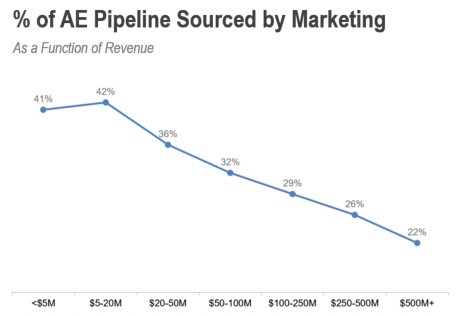
When I managed marketing for the fast-growing SaaS company Incapsula, I depended a lot on inbound marketing methods to drive our demand generation. At first, everything went well, but soon I saw that the pace of leads from marketing started to slow down and fell short of the business’s growth goals. What went wrong? I had fallen into what I call “the inbound trap.” Let me clarify.
Inbound marketing employs strategies that draw customers to you. At its heart is producing content that engages buyers. Usually, it combines content marketing and search engine optimization (SEO). You focus on issues or challenges that matter to your buyers and relate to your product, ensuring that this content performs well on Google search results.
Outbound marketing uses conventional methods like direct mail, email, advertising, content syndication and event marketing. The easiest way to contrast inbound and outbound is to compare SEO with direct email. Search engine marketing works well because you are engaging with the buyer at the time they are looking to solve a problem. Email marketing usually starts with a database of likely buyers. You send them emails with (hopefully) attractive offers and hope they bite. Most often, however, your emails are deleted without being read.
So, what’s the inbound trap? Quite simply it is relying too heavily, or for too long, on inbound marketing. It can happen quite easily. Inbound is addictive. The leads are high quality and cheap. That’s because you are finding the buyer when they are ready to buy, and creating content of your own is less expensive than most outbound techniques.
Here was my journey at Incapsula. I broke it down into three distinct stages: $25, $50, and $100 million. Your mileage will definitely vary, but I think you can break down your growth path into three similar stages. What’s important is recognizing where you are and knowing when to add resources. And most of all, don’t fall into the inbound trap.
$25 Million
Ultimately, if you have a growth business, you will get to a point where the volume of prospects coming to you is not high enough. When that happens really depends on your company. In my experience, inbound alone won’t work when you get north of $25 million in bookings. It’s likely at this stage that you may already be utilizing Google AdWords and going to a few events. You can look at adding events, but they are the most expensive part of the marketing mix. My recommendation is to take a look at your cost per opportunity from AdWords and see if you have the budget to increase your funnel a meaningful amount (10%+) by spending more on paid advertising. NB: If you have not been spending much energy optimizing your PPC campaigns, this would be a good time to start.
$50 Million
When you get over $50 million in bookings, you really need a good balance of inbound and outbound. This is when I had that feeling that something wasn’t right. I couldn’t quite put my finger on it at the time, but I was sliding into the inbound trap. We were doing a small number of events and had a pretty well optimized AdWords campaign that I had added funding to. To counter the slide, my strategy was to go bigger with email.
A slight pause here to make an important distinction on email. Sending emails to your house list or blog subscribers is not, strictly speaking, outbound.
A slight pause here to make an important distinction on email. Sending emails to your house list or blog subscribers is not, strictly speaking, outbound. These people have already found you and may have signed up to receive your emails. It’s what Seth Godin calls “permission marketing.” Sending emails to lists you buy is outbound. That’s what I did. I called it “Project M,” which stood for “massive mailing move.” We knew our buyers very well by then – titles, problems, and what kind of assets worked. We even had predictive lead scoring in place, so there were a bunch of other signals we used to tune our lists. Too long to get into the details here, but I bought hundreds of thousands of names and started outbound emailing, with timely follow up by a sales development rep.
Also, at this stage, if it’s appropriate for your business, you probably want to start looking into how partners can help you. For many products, this means adding or growing the channel – resellers and distributors. There are a number of things you can do, from increasing recruitment, to adding rebates, or running a channel promotion (like a trip to the Super Bowl for the top channel rep). If you are an online business that relies on referrals, you may want to build an affiliate program.
$100 Million
When you get to this stage, something really painful happens. I experienced it firsthand. My sales team had gotten used to marketing delivering leads, first from inbound techniques, and then from outbound techniques. The leads had gotten harder for them to convert. Remember, inbound leads are usually ready to buy. The outbound leads were much earlier in, or not even in, the buying cycle, so they weren’t as good in the eyes of the salespeople, even if they did eventually convert.
At this later stage, you need to have the conversation about sales outbound, aka cold calling or using their Rolodex. Most sales leaders know this is inevitable, but it’s never popular. It probably also means an increased investment in sales development reps.
But it’s true. Take a look at the graph below, from a study by the Bridge Group. You can see that the average amount sourced by marketing peaks in the $5 million to $20 million stage. As I said above, your mileage will vary. We peaked later and had an overall larger contribution from marketing.
Figure 1: The amount of pipeline sourced by the marketing team falls as revenue grows. Source: The Bridge Group.
One last thing to consider is cost. Depending on your average selling price, some outbound techniques may be cost prohibitive. This is where you need to understand you customer acquisition cost (CAC) and how long it takes you to make your money back, using the CAC ratio.
The cliffs I described above are from my experience. As you can see in the Bridge Group survey, the average is different from my experience, which means there are people who will have to go outbound sooner, and some later.
But whatever your case, just being aware of the inbound trap hopefully means you won’t fall in, whenever it comes.
